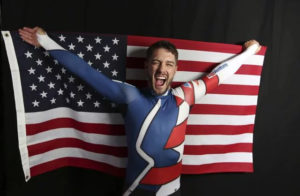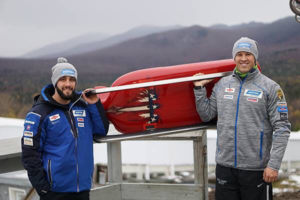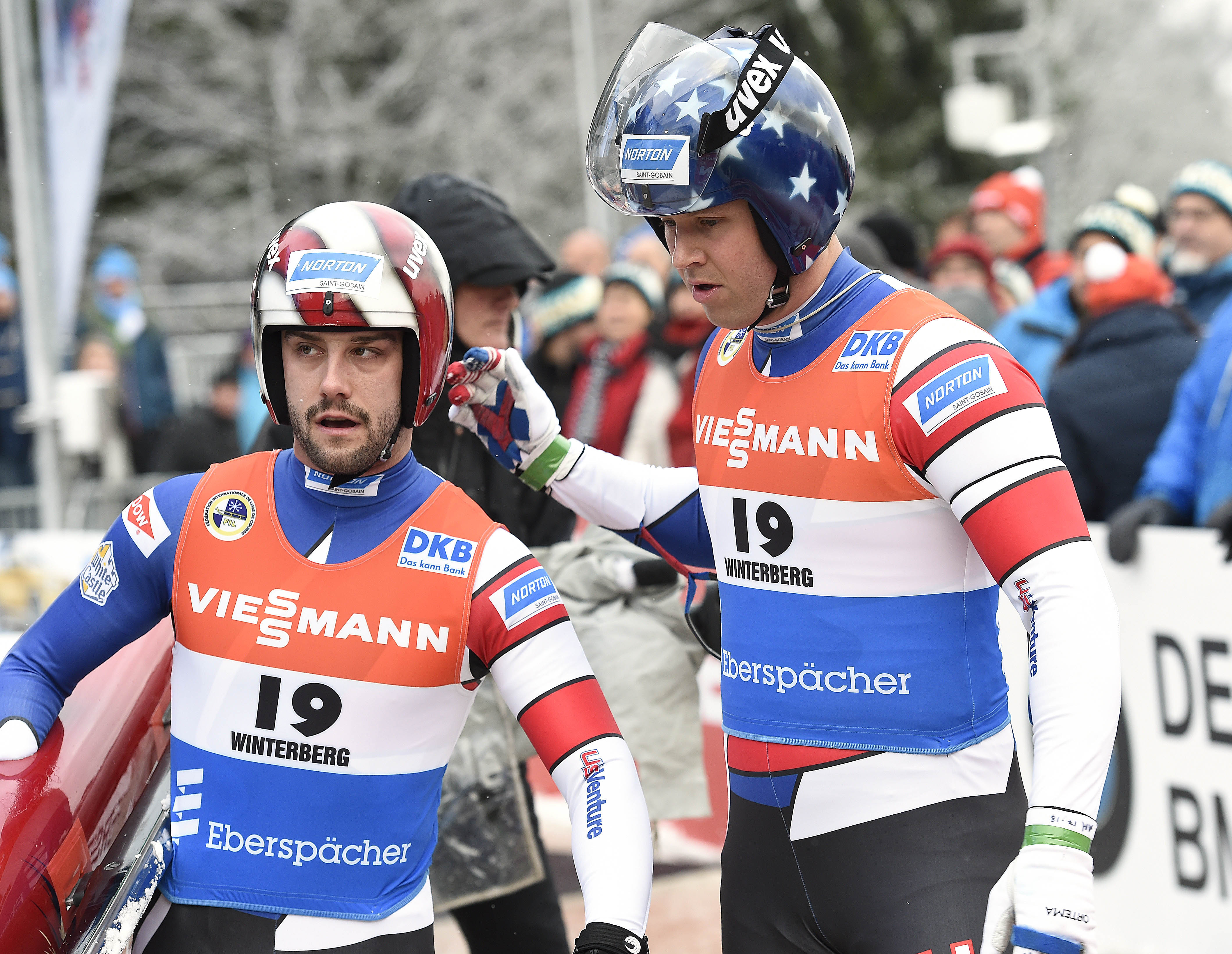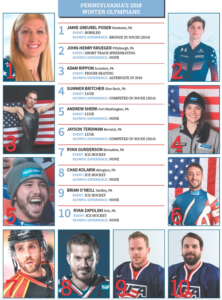
Kathryn Terdiman approached her 10-year-old son in their Berwick home with a flyer that has drastically changed both their lives in the 18 years since.
“She had seen a flyer about luge tryouts. She asked me if I wanted to try it,” Jayson remembered. “Being a typical kid from Berwick, I asked her what Luge was.”
Kathryn’s response: “I don’t know, but the people on the flyer look like they are having fun!”
The exchange was the spark of what has become an Olympic experience for Jayson, who competed at the 2014 Winter Olympics in Sochi and will represent the United States again this year in the luge doubles event.
“The Olympics are their own beast altogether,” he said. “We’re lucky to have a few hundred show up for typical race weekends in luge, but then you show up for the Olympics, and there are thousands there in person and broadcasters sharing your every move with millions of people around the world. It is an unbelievable experience, and there is a lot of pride to be out there trying to win a medal for your country.”

Crash course in luge
Jayson’s first run in a luge-type sled ended in a wreck.
“From the flyer my mom showed me, we drove to a luge clinic in Rochester, New York. I had no idea what I was getting into,” he said.
In the clinics, the USA luge organization puts young people in modified luge sleds where the typical steel runner blades are replaced with wheels, according to Jayson. After a short introduction, kids tackle a makeshift downhill course marked by cones and straw bales reminiscent of the training sequences from the movie “Cool Runnings.”
“At the time, I didn’t know what they wanted, but since then I’ve been involved in running these types of clinics and we look for coachability and natural talent,” Jayson said. “My first run (as a 10-year-old kid), I flew off the track and into some hay bales. The coaches there showed me one little thing I was doing wrong, and I had no other issues the rest of the day.”
There is obviously a very steep learning curve from the initial kids clinic to competing in an Olympic setting on a tiny luge sled hurtling down the track upwards of 90 miles an hour where even the slightest movement can lead to a dire situation.
“This is an experience sport. It takes about six to 10 years to get comfortable, which is why we shoot for younger athletes,” Jayson said. “The best in the world make it look like you are just laying there going down the track, but in reality, we are in control of every movement. It takes a lot of concentration and developing a feel for the sport.”
Pre-Olympics practicing limits the physical aspects of being on the track, forcing athletes to do most of their preparation mentally.
“We get six practice runs, and you’re only on the course about a minute each run, so technically we get just six minutes of physical, on-the-track practice,” he said. “The rest of the time, we are doing mind runs, mentally anticipating what each turn will be like and how to adjust to each situation.”
Again, Jayson admitted the experience is similar to what is shown in the movie “Cool Runnings,” a film he uses to explain the sport to youngsters during the offseason.
“I talk at schools, and I use the movie as a reference,” he said. “I used to get a lot of response when I’d mention the movie, but now most kids haven’t seen it.”

Building a winning resume
Jayson’s first Olympic experience in the doubles luge event in Sochi, Russia in 2014 ended in an 11th place finish. He was paired with Christian Niccum for that event.
“When we qualified for Sochi, the goal was to go into those Olympics as a learning experience, to take it all in and get the feeling so that when and if I was able to qualify for Pyeongchang (South Korea), I could be past the bug-eyed part of competing in the Olympics and be able to get down to business,” he said.
This year’s doubles teammate, Matt Mortensen, of Huntington Station, New York, also participated in the Sochi Olympics and knows what to expect this time around. The two have competed in a variety of World Cup events to build chemistry and tweak their strategy ahead of this year’s Olympic run.
“We’ve been looking to improve our speed. Jayson and I have been messing around with equipment to figure out what the fastest options will be for Pyeongchang,” Mortensen said.
Competing as a pair adds an additional level of difficulty on the luge track.
“While we are in a run, there is no headset or microphone to communicate. It requires a lot of trust,” Jayson said. “There is no such thing as a perfect run, so we have to improvise on the fly without being able to talk about it.”
How do they develop the chemistry necessary to be successful?
“When we are on tour, we live together about five months out of the year. We compare it to a marriage,” Jayson joked.
The two have had quite a bit of success in the World Cup circuit, breaking into the Germany luging powerhouse and building the confidence necessary to be a real contender at the games. That success hinges on each of the pair fulfilling responsibilities while traveling at high rates of speed down the course.
“Matt is on top, so he can see completely. He is in charge of all the fine adjustments where they need to be,” Jayson said. “I am in contact with the sled more than him, so I’m focused on the steering through the curves. I’m more of the engine than him. Matt’s more of the driver, and I am supplementing him the whole way down.”
The times at the Pyeongchang track range about 46 to 47 seconds per run.
“Our fastest run there right now is 46.8 seconds,” Jayson said. “And all competitive luge tracks are roughly one mile long.”

Regional representation
Jayson is one of three luge-focused athletes with Pennsylvania ties competing in this year’s Olympics.
Andrew Sherk, of Fort Washington, will be one half of Team USA’s other doubles team — a pairing of first-time Olympic competitors.
Summer Britcher, of Glen Rock, is competing in her second Olympic experience in the individual female luge competition.
“The experience of competing in the Olympics is incredible. There is nothing else like it — to fulfill a lifelong ambition while representing your country,” she said. “I hope when I am out there to give a message to other young girls that they can follow their dreams and achieve anything as long as they are willing to put in the work.”
For Sherk, this year’s games will be a matter of building experience on such a big stage.
“Once you get past the start, it all becomes second nature,” he said. “I’m focused on going out there and having a good time.”
Doing so may seem to be hard considering the growing political tension in the Korean region of the world, but Jayson admitted that he and the other athletes are zeroed in on their specific sports.
“I’m focused on doing what we’ve been training to do for quite a while. I trust that the Olympic committee and the people of Pyeongchang will keep things safe for all of us,” he said. “I can only control the 46 seconds of ice time I have, and hopefully through that, we can bring home a medal for the United States.”
For more information about the 2018 Winter Olympics, visit teamusa.org and click on the 2018 Olympics link at the top of the page.



